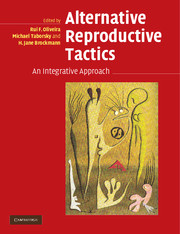Book contents
- Frontmatter
- Contents
- List of contributors
- Preface
- 1 The evolution of alternative reproductive tactics: concepts and questions
- PART I ULTIMATE CAUSES AND ORIGINS OF ALTERNATIVE REPRODUCTIVE TACTICS
- PART II PROXIMATE MECHANISMS OF ALTERNATIVE REPRODUCTIVE TACTICS
- PART III TAXONOMIC REVIEWS OF ALTERNATIVE REPRODUCTIVE TACTICS
- 8 Alternative reproductive tactics in insects
- 9 The expression of crustacean mating strategies
- 10 Alternative reproductive tactics in fish
- 11 Alternative reproductive tactics in amphibians
- 12 Alternative reproductive tactics in reptiles
- 13 Alternative reproductive tactics in birds
- 14 Alternative reproductive tactics in nonprimate male mammals
- 15 Alternative reproductive tactics in primates
- PART IV EMERGING PERSPECTIVES ON ALTERNATIVE REPRODUCTIVE TACTICS
- Index of species
- Subject index
- References
12 - Alternative reproductive tactics in reptiles
Published online by Cambridge University Press: 10 August 2009
- Frontmatter
- Contents
- List of contributors
- Preface
- 1 The evolution of alternative reproductive tactics: concepts and questions
- PART I ULTIMATE CAUSES AND ORIGINS OF ALTERNATIVE REPRODUCTIVE TACTICS
- PART II PROXIMATE MECHANISMS OF ALTERNATIVE REPRODUCTIVE TACTICS
- PART III TAXONOMIC REVIEWS OF ALTERNATIVE REPRODUCTIVE TACTICS
- 8 Alternative reproductive tactics in insects
- 9 The expression of crustacean mating strategies
- 10 Alternative reproductive tactics in fish
- 11 Alternative reproductive tactics in amphibians
- 12 Alternative reproductive tactics in reptiles
- 13 Alternative reproductive tactics in birds
- 14 Alternative reproductive tactics in nonprimate male mammals
- 15 Alternative reproductive tactics in primates
- PART IV EMERGING PERSPECTIVES ON ALTERNATIVE REPRODUCTIVE TACTICS
- Index of species
- Subject index
- References
Summary
CHAPTER SUMMARY
In this chapter we explore the diversity of alternative reproductive tactics (ARTs) exhibited by reptiles. There is a rich literature on ARTs in a broad diversity of reptile lineages, and our contribution is therefore not an exhaustive one. Rather, we attempt to cover topics of general significance to many fields of study, including differences in male and female reproductive behavior, sex ratio adjustment and progeny gender manipulation, and the role of parthenogenesis in mating systems. Our goal is to provide a representative portrait of the diversity of tactics displayed among reptilian lineages, but we often illustrate more elaborate points using data from side-blotched lizards, Uta stansburiana, a system that we have been working on together for a decade. Throughout the chapter we emphasize the distinction between the proximate and the ultimate mechanisms that underlie the evolution of alternative tactics. We conclude with a brief discussion of potentially exciting future research directions in reptilian systems.
INTRODUCTION
Exploring alternative reproductive tactics (ARTs) in reptiles presents a great challenge given the diverse nature of these taxa. Modern reptilian lineages are paraphyletic with ancient histories. Some extinct reptilian groups such as the dinosaurs undoubtedly exhibited alternative reproductive tactics, given the documented dichotomy between precocial (Geist and Jones 1996, Varricchio et al. 1997) and altricial young (Horner 2000) in various dinosaur lineages. This dichotomy in the developmental tactics of young is strongly associated with the mating systems in the surviving descendants of dinosaurs, the birds.
- Type
- Chapter
- Information
- Alternative Reproductive TacticsAn Integrative Approach, pp. 332 - 342Publisher: Cambridge University PressPrint publication year: 2008
References
- 12
- Cited by



